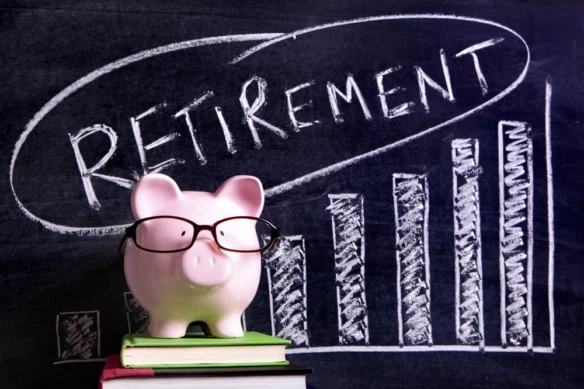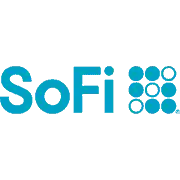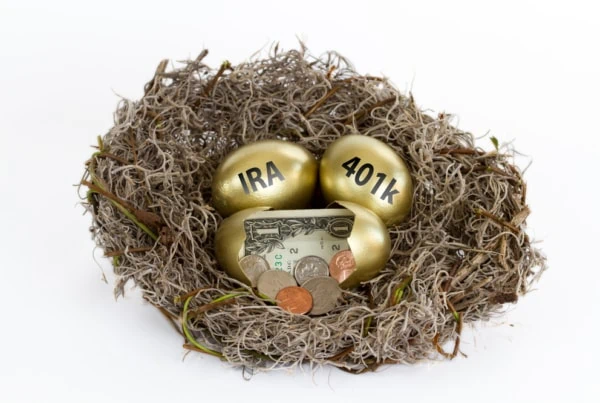If you’re self-employed, you have multiple options when it comes to saving for retirement. Of course, an individual retirement account (IRA) is always on the menu, and two of the most popular IRA choices for self-employed people are SEP IRAs and Roth IRAs.
Both are tax-advantaged accounts that are easy to open and maintain. However, there are important differences with regard to eligibility, contributions, tax treatment, and more.
But don’t worry if you’re trying to figure out which of these two IRAs is best for you. We’ll give you a rundown of both types of accounts, point out their differences, and list some of the pros and cons of each. The goal is to help you decide whether a SEP IRA or a Roth IRA makes more sense for you.
The hard part was earning all the money you plan to save for retirement. The easy part will be choosing an account to invest and grow that money.
Related: What’s the Retirement Saver’s Tax Credit?
What Is a SEP IRA and How Does It Work?
A Simplified Employee Pension (SEP) IRA is a retirement account designed for small business owners and self-employed people. Any business owner with one or more employees, or any self-employed person (e.g., a freelancer), can open a SEP IRA. These accounts are simple to set up and have low administrative costs.
The first step for someone who wants to set up a SEP IRA is to pick a trustee (e.g., a financial institution) to hold the retirement plan assets. If you’re a business owner with employees, the trustee will set up a separate account for each eligible worker.
If you’re self-employed, you will make contributions to your own account. Business owners with employees can’t use a SEP IRA just for themselves—they must also contribute to each eligible employee’s separate account.
A self-employed person or business owner chooses how much to contribute to their own SEP IRA and, if applicable, to the separate accounts for each employee. There are contribution limits, though (more on the limits in a minute).
For self-employed people and business owners, the contribution amount is a percentage of your compensation. Likewise, contributions for workers are based on a percentage of their compensation. However, the contribution percentage must be the same for all eligible employees. The annual contribution percentage can also be changed each year (even to 0%).
Employees can’t contribute their own money to the SEP IRA account set up for them, but they can make their own investment decisions.
SEP IRA contributions are always fully vested, so an employee owns 100% of any money in his or her separate account.
How Is Money In a SEP IRA Taxed?
A SEP IRA account is funded with “pre-tax” income. Basically, that means contributions to a SEP IRA aren’t included in taxable income, so they’re made before income tax is imposed on those funds. For self-employed people and business owners, contributions are excluded from taxable income through a tax deduction. For employees, contributions aren’t included in their gross income from employment (i.e., they’re not counted as wages or other taxable compensation).
Once in the account, taxes are deferred until the money is withdrawn. When money is taken out of a SEP IRA, income taxes must be paid on the amount at the same federal tax rate applied to the account holder’s wages, tips, taxable Social Security benefits, and other “ordinary” income.
Withdrawals made before the account holder is 59½ years old are generally hit with a 10% early distribution penalty (although there are exceptions).
When an account holder turns 73, a certain amount of money must be taken out of his or her SEP IRA account each year. These mandatory withdrawals are called “required minimum distributions” (RMDs).
Young and the Invested Tip: The age when RMDs kick in jumps to 75 starting in 2033. It was 72 before 2023.
Are There Eligibility Requirements for a SEP IRA?
Yes, there are eligibility requirements for SEP IRAs. To start, only a business owner or self-employed person can establish a SEP IRA.
As for employees, including those who earn self-employment income, there are baseline eligibility requirements for receiving SEP IRA contributions. For 2025, they must meet all of the following requirements:
- At least 21 years old
- Work for the employer at least three of the past five years
- Earn a minimum of $750 in compensation during the year (increases to $800 in 2026)
It’s important to note that employers are allowed to establish less restrictive requirements, but they can’t apply more restrictive ones. So, for example, a business owner can choose to open a SEP IRA for all employees regardless of age, service time, or compensation. However, a SEP IRA can’t require employees to be at least 22 years old, work for business at least four of the last five years, and earn at least $850.
The employer is allowed to exclude employees if they’re part of a union that bargained for retirement benefits in good faith and any nonresident alien employees.
What Are the Contribution Limits for SEP IRAs?
For 2025, contributions are based only on the first $350,000 of compensation ($360,000 for 2026).
In addition, employer contributions to a SEP IRA can’t exceed 25% of an employee’s salary or $70,000 for 2025 ($72,000 for 2026), whichever is lower.
Also, additional “catch-up” contributions for employers who are at least 50 years old aren’t allowed with a SEP IRA.
If you’re self-employed, you must use a special calculation to determine your personal contribution limits. Your compensation is equal to your net earnings from self-employment, minus any contributions to your own SEP IRA and half of your self-employment tax.
What Investment Options Do You Have With a SEP IRA?
SEP IRAs offer many investment options, such as stocks, mutual funds, savings accounts, money market funds, exchange traded funds (ETFs), and other similar investments. Like a traditional IRA, there are some restrictions on coins, collectibles, real estate you get a direct benefit from, and some types of derivative positions.
Employees make their own investment decisions on how to manage their SEP IRAs. However, workers should avoid investing in non-publicly traded assets or assets that they directly control.
Who Is a SEP IRA Best For?
A SEP IRA is a great option for self-employed people and small business owners wanting to avoid the high opening and operating costs that come with many employer-sponsored retirement plans. In most situations, it also has higher contribution limits than a traditional or Roth IRA.
For those who want a tax deduction right away, a SEP IRA might also be the way to go.
Where Can I Open a SEP IRA?
SEP IRAs can be opened with most major brokerage firms. For example, SoFi Invest® offers SEP IRAs with no annual account fees, no opening fee, and no minimums to open an account. There are also no commission fees for online U.S. stock, ETF, and options trades.
Large brokers like SoFi also offer a wide range of stocks, ETFs, and more investment options.
- SoFi Invest's SEP IRA allows you to trade or invest in stocks, ETFs, and options with no commissions (or options contract fees) and no account minimums.
- Invest for as little as $5 with fractional shares.
- Robo-advisory services, including goal planning and auto-rebalancing, available for annual 0.25% AUM fee.
- Subscribe to SoFi Plus ($10/mo.) to unlock more than $1,000 per year in extra value, including a 1% match on recurring investment deposits, preferred IPO access, higher cash-back rewards on certain SoFi credit cards, a six-month APY boost, and more.
- No opening fees
- Good selection of available investments
- No options contract fees
- DIY and robo-investing options
- Fractional shares
- Modest closing fee ($20)
- No mutual funds
- Limited trading tools
- No tax-loss harvesting
- No socially responsible robo-advisor functionality
Related: How to Use Your HSA for Retirement
What Is a Roth IRA and How Does It Work?
Although Roth IRAs can be great for self-employed people, they’re actually a common retirement account that any low- or moderate-income person with earned income can open (even children can open a Roth IRA). The best part about a Roth IRA is that it won’t increase your tax burden during retirement.
Since there are income limits, not everybody is eligible to contribute to a Roth IRA. For 2025, you can’t contribute to a Roth IRA at all if your modified adjusted gross income (AGI) for the year is:
- $165,001 or more if you use the single or head of household filing status on your tax return ($168,001 in 2026)
- $246,001 or more if you’re married and file a joint return ($252,001 in 2026)
Plus, even if your income isn’t that high, the annual maximum contribution amount is gradually reduced to zero if your 2025 modified AGI is:
- $150,000 to $165,000 for single and head-of-household filers ($153,000 to $168,000 in 2025)
- $236,000 to $246,000 for joint filers ($242,000 to $252,000 in 2025)
- If you’re married but file a separate tax return, your annual maximum contribution is gradually reduced to zero if your modified AGI is between $0 and $10,000.
There is no minimum amount you need to earn to open Roth IRAs. Any person who has earned income can open an account.
How Is Money In a Roth IRA Taxed?
People with Roth IRAs contribute to their accounts with “after-tax”dollars, meaning contributions are not tax deductible. Contributions (not earnings) can be taken out tax-free at any time since that money was already taxed.
Money in a Roth IRA grows tax-free, and you don’t have to pay taxes on withdrawals if you take money out of the account after age 59½ if you’ve had a Roth IRA for at least five years. If you’re under age 59½, or you haven’t had a Roth IRA for at least five years, the earnings are subject to tax and a 10% early withdrawal penalty.
Fortunately, there are several exceptions to the 10% penalty if you use the funds for certain things (although you still must pay taxes on early withdrawals). Examples of exceptions include using Roth IRA funds for:
- Purchasing your first home (waiver up to $10,000)
- Higher education expenses
- Birth or adoption expenses
- Medical insurance if you’re unemployed
In addition, the penalty is waived if you become disabled or terminally ill. You can also avoid the penalty if distributions are made in substantially equal periodic payments (talk to a certified financial planner before setting up these distributions).
RMDs don’t apply to Roth IRAs, so withdrawals are never required until after the death of the account owner.
What Are the Contribution Limits for Roth IRAs?
The 2025 contribution limit for Roth IRAs is $7,000. Limits are adjusted annually for inflation; in 2026, the limit has been raised to $7,500. For anyone with multiple IRAs (including both Roth and traditional IRAs), that’s a joint limit for what you can contribute annually to all IRA accounts. For example, if you contributed $1,000 to a traditional IRA, you can only contribute $6,000 to your Roth IRA in 2025.
You cannot contribute more to an account than the income you earned that year. If you earned less than $7,000, your earned income is your limit.
“Catch-up” contributions are permitted for anyone aged 50 and older. For 2025, the catch-up contribution can be up to $1,000, for a combined cap of $8,000. This too is now adjusted annually for inflation; in 2026, the catch-up contribution will be $1,100, for a total cap of $8,600.
What Investment Options Do You Have With a Roth IRA?
Roth IRAs offer a vast variety of investment choices. You can invest in stocks, bonds, ETFs, mutual funds, real estate investment trusts (REITs), and much more. Some providers even let you invest in riskier investments, such as options.
Who Is a Roth IRA Best For?
A Roth IRA is an excellent account for anyone who expects to have a higher income during retirement and wants to lower their tax burden in the future.
Where Can I Open a Roth IRA?
If you’re thinking of opening a Roth IRA but don’t know where to start, SoFi Invest® is a great app to consider. One great benefit of SoFi is that you can contribute at any time with zero-commission equity trades in your account.
You’ll also have access to the best features of a traditional brokerage, while also leveraging the digital automation capabilities of the SoFi Invest robo-advisory platform.
Further, you can roll over all of your current IRAs and 401(k) accounts hassle-free to SoFi.
- SoFi Invest's Roth IRA allows you to trade or invest in stocks, ETFs, and options with no commissions (or options contract fees) and no account minimums.
- Invest for as little as $5 with fractional shares.
- Robo-advisory services, including goal planning and auto-rebalancing, available for annual 0.25% AUM fee.
- Subscribe to SoFi Plus ($10/mo.) to unlock more than $1,000 per year in extra value, including a 1% match on recurring investment deposits, preferred IPO access, higher cash-back rewards on certain SoFi credit cards, a six-month APY boost, and more.
- No opening fees
- Good selection of available investments
- No options contract fees
- DIY and robo-investing options
- Fractional shares
- Modest closing fee ($20)
- No mutual funds
- Limited trading tools
- No tax-loss harvesting
- No socially responsible robo-advisor functionality
Related: Best Investments for Roth IRA Accounts
SEP IRA vs. Roth IRA: Main Differences + Pros and Cons
Now that we’ve covered the basics of both SEP IRAs and Roth IRAs, let’s start comparing and contrasting these two types of retirement accounts. We’ll also lay out the pros and cons of both.
Main Differences Between SEP IRAs and Roth IRAs
There are many differences between SEP IRAs and Roth IRAs. We see the following as the three main differences:
1. Availability
A SEP IRA is only available to self-employed people and business owners, while Roth IRAs are only available to individuals.
2. Contribution limits
The account with the higher contribution limit for you depends on how much money you earn. For many self-employed people and business owners, the SEP IRA limit is higher. A quick guide:
- If you’re under 50 and earn more than $28,000 ($7,000 x 4) in 2025, or more than $30,000 in 2026 ($7,500) you can contribute more to a SEP IRA.
- If you’re under 50 years old and earn less than $28,000 in 2025, or less than $30,000 in 2026, your Roth IRA contribution limit is higher.
However, don’t forget that higher-income people can either have their contribution limit reduced—potentially to $0.
3. Taxation of funds
Tax breaks are available for both SEP IRAs and Roth IRAs. However, when you get those tax breaks is different.
You get a tax deduction when you contribute to a SEP IRA, but pay tax on withdrawals. So, a SEP IRA might be the better choice if you expect to be in a lower federal tax bracket in retirement.
On the other hand, there are no tax breaks when you contribute to a Roth IRA, but withdrawals after age 59½ are completely tax-free. So, consider a Roth IRA if you expect to be in a higher tax bracket when you retire.
What Are the Advantages and Disadvantages of a SEP IRA?
Let’s take a quick look at some of the pros and cons of SEP IRAs:
Advantages
- Easy and inexpensive to set up
- Tax deduction for contributions
- Investments grow tax-deferred
- High contribution limits
Disadvantages
- Employers have to make equal percentage contributions for all eligible employees
- Only employer contributions are allowed
- Several requirements to be an eligible employee (minimum age, years worked, compensation)
- Catch-up contributions not allowed
What are the Advantages and Disadvantages of a Roth IRA?
How about Roth IRAs? What are some of the pros and cons for them?
Advantages
- Easy and inexpensive to set up
- Tax-free growth on investments
- Contributions can be withdrawn at any time with no penalty
- Tax-free withdrawals (contributions and earnings) after age 59½
- Not subject to RMDs
Disadvantages
- No tax deduction for contributions
- Low contribution limits
- Income limits prevent some people from making contributions
- No employer contributions
Related: Estimated Tax Due Dates for Self-Employed People
Can I Have Both a SEP IRA and a Roth IRA?
Yes, a self-employed person or business owner can have both a SEP IRA and a Roth IRA as long as the eligibility requirements for both are satisfied.
In fact, if you have enough money to contribute to both, the accounts can complement each other. For instance, if you contribute to both in a single year, you’ll not only reduce your taxable income by the amount put in a SEP IRA, but you’ll also benefit from the tax-free growth of money put in a Roth IRA.
Young and the Invested Tip: Employees with a SEP IRA funded by their employer can also contribute to their own Roth IRA.
Related: Best Long-Term Stocks to Buy and Hold Forever
Is a SEP IRA Better than a Roth IRA?
Let’s recap. For self-employed people, SEP IRAs and Roth IRAs are both great options for retirement plans. Each account has its own set of benefits.
In terms of which account is better, it varies by person. To start, there are different eligibility requirements for both, so in some circumstances the better option for you is whichever one you’re qualified to open!
For people making more than $28,000 in 2025, a SEP IRA probably has higher contribution limits. So, if you need a higher limit, go with a SEP IRA.
Anyone who might want to pull money from their retirement account prior to retirement, such as for buying a first home, should probably lean towards a Roth IRA since you can withdraw contributions (and in some situations earnings) with no tax or penalty.
Retirement savers hoping to reduce their taxable income now should opt for the SEP IRA, whereas someone who wants to reduce their tax burden during retirement should go with a Roth IRA.
Besides those factors, which account is better is largely a matter of preference and how it fits in with any other retirement accounts you own. And, of course, self-employed people and business owners can always use both a SEP IRA and Roth IRA to maximize tax benefits.
Young and the Invested Tip: Other retirement accounts that a self-employed person can open include a solo 401(k) plan, traditional IRA, and Savings Incentive Match Plan for Employees (SIMPLE) IRA or 401(k).
Related:












![Should You Max Out Your 401(k) Each Year? [Yes...and No] 17 should you max out your 401k each year or invest elsewhere](https://youngandtheinvested.com/wp-content/uploads/should-you-max-out-your-401k-each-year-or-invest-elsewhere-600x403.webp)

